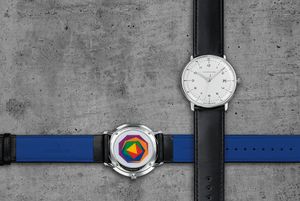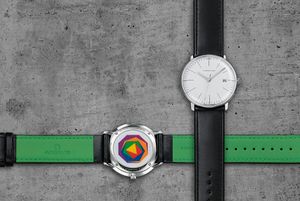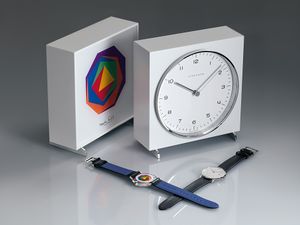Junghans: From variation to fascination
Press release
Schramberg, February 2017
From variation to fascination
The new max bill Edition 2017 combines two works of art by Max Bill: the wristwatch that he designed and his "grafische reihen" – a top tip, and not only for Bauhaus enthusiasts.
Junghans and Max Bill: experience design history
The max bill classic from Junghans is available as a special edition in 2017. A fascinating timepiece that fully embodies the Bauhaus philosophy, reflecting the core motto of "form follows function" in every detail. On the back of the Edition 2017 the "variation 1" print from the "grafische reihen" (graphic series) by Max Bill can be seen, distinguishing the model as a top tip for connoisseurs – and enabling them to carry the creativeness of the architect with them at all times. The "grafische reihen" reflects the continuous development from one geometric form to the next, also incorporating a mathematical aspect: one side of a polygon simultaneously forms one side of the next polygon. The artist referred to his work as "a pure interaction of form and colour ... the sole purpose of which is to delight with its existence". It was created in the early years of his career (1935-1938), after attending the Bauhaus in Dessau, founded as an art school by Walter Gropius. The timepiece is also derived from the perfect sense of proportion of Max Bill, who created the first wristwatches for Junghans in 1961 – a close association that lends a particular expressiveness to this model.
The JUNGHANS max bill Edition 2017 is available in two exciting variants: with a lined index dial for admirers of absolute purism or a dial featuring the Max Bill typography with arabic numbers for the hour markers. Both versions are equipped with a special strap featuring the colours used in "variation 1" on the lining leather.
Limited edition set for collectors
The exclusive edition set is limited to 222 – a limitation derived from the number 22, which had particular significance for Max Bill, as both his birthday and the date of his wedding to his wife Binia fell on the 22nd day of the month. Max Bill always reserved the no. 22 of limited art works for himself. In addition to the wristwatch, the set also includes a Bauhaus-style table clock with quartz movement, the back of which also displays "variation 1" of the "grafische reihen" by Max Bill. Two design classics that will quicken the pulse of every lover of design – both on the wrist and in the home.
The JUNGHANS max bill range
In keeping with the premise "form follows function", artist and Bauhaus scholar Max Bill created a timepiece of a very special kind. The logical dial design of the 1956 Max Bill kitchen clock, a design milestone, became the characteristic feature of his timepieces, incorporated into the design of the first Max Bill wristwatches in 1961. The artist placed particular emphasis on the combination of utilitarian value and beauty. With clear lines and the strive for aesthetic perfection, the design classics of the JUNGHANS max bill range are still created in nearly the same way.
Junghans – The German watch
Junghans was founded in the Black Forest town of Schramberg in 1851. Over 150 years of expertise in precision and design is reflected in memorable milestones: In 1093 Junghans was the largest watch manufacturer in the world, with over 3,000 employees. The development of precision movements made the company the largest German manufacturer of chronometers in 1951 and the third largest worldwide in 1956. In 1972 Junghans was the official timekeeper of the Olympic Games in Munich, setting new standards in timekeeping. After an eventful and turbulent company history, the Schramberg entrepreneurs Dr. Hans-Jochem and Hannes Steim became the new owners of the venerable company in 2009. Each watch is produced in Schramberg with great attention to detail, technological expertise and high standards of design and quality. The collection comprises charismatic timepieces: The Meister watches, which have been produced since the 1930s, reflect the history and present of the company. In 1956 Max Bill designed watches that have become absolute classics. Distinguished by the Bauhaus philosophy, they are still produced today in nearly unchanged form. Junghans set new standards in 1990 with the invention of the radio-controlled wristwatch – a technology that is still used today, in combination with environ-mentally-friendly solar power. A wide variety of technology as unique as the watches bearing the star.



